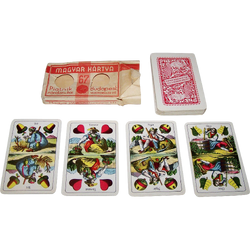| Joel Brand's Playing Cards | |
|---|---|

| |
|
Origin |
Joel Brand |
|
Type |
Playing Cards |
|
Effects |
Will attack the target |
|
Downsides |
Drains victim’s blood to fashion supplies |
|
Activation |
Throwing |
|
Collected by |
Warehouse 13 |
|
Section |
|
|
Aisle |
28D-03B |
|
Shelf |
268535-8819-176 |
|
Date of Collection |
June 1, 1992 |
| [Source] | |
Origin[]
Joel Brand was a rescue worker who became known during the Holocaust for his efforts to save Hungary's Jews from deportation to Auschwitz, after the German invasion of that country in March 1944. A leading member of Budapest's Aid and Rescue Committee, which smuggled Jews out of occupied Europe, Brand was approached in April 1944 by Adolf Eichmann, the German officer in charge of deportations. Eichmann proposed that Brand broker a deal between the SS and the United States or Britain, in which the Nazis would exchange one million Jews for 10,000 trucks for the Eastern front and large quantities of tea and other goods. It was the most ambitious of a series of such deals between Nazi and Jewish leaders; Eichmann called it "Blut gegen Waren" ("blood for goods").
Nothing came of the proposal, which the London Times called one of the most loathsome stories of the war. Historians believe that the SS, including its commander, Heinrich Himmler, intended the negotiations as cover for peace talks with the Western Allies that would exclude the Soviet Union and perhaps even Adolf Hitler. Whatever its purpose, the proposal was thwarted by the British government; they arrested Brand in Aleppo. He told an interviewer shortly before his death in 1964: "An accident of life placed the fate of one million human beings on my shoulders. I eat and sleep and think only of them."
Effects[]
Throwing the cards makes them attack the target(s), constantly circling around and trying to slash at anything soft or brittle with their razor sharp edges. They will follow the target if mobile and strike in succession if they find a vulnerable area. It has a particularly alarming downside when it cuts people. All the blood within the user will be drawn out of any open wounds in a shimmering ribbon until they are completely drained. The blood is then compacted together and, using the available compounds, transforms it into a valuable object. Valuable in the sense that the victim has a personal history with that particular object. Its correct usage or presence could have prevented horrible misfortunes on somebody in their past, and the blood collection and transformation is how the artifact sees the debt repayment fulfilled.
